Reflecting and Evaluating:
Workshop 1 – Reflection
Session Plan Workshop 1:
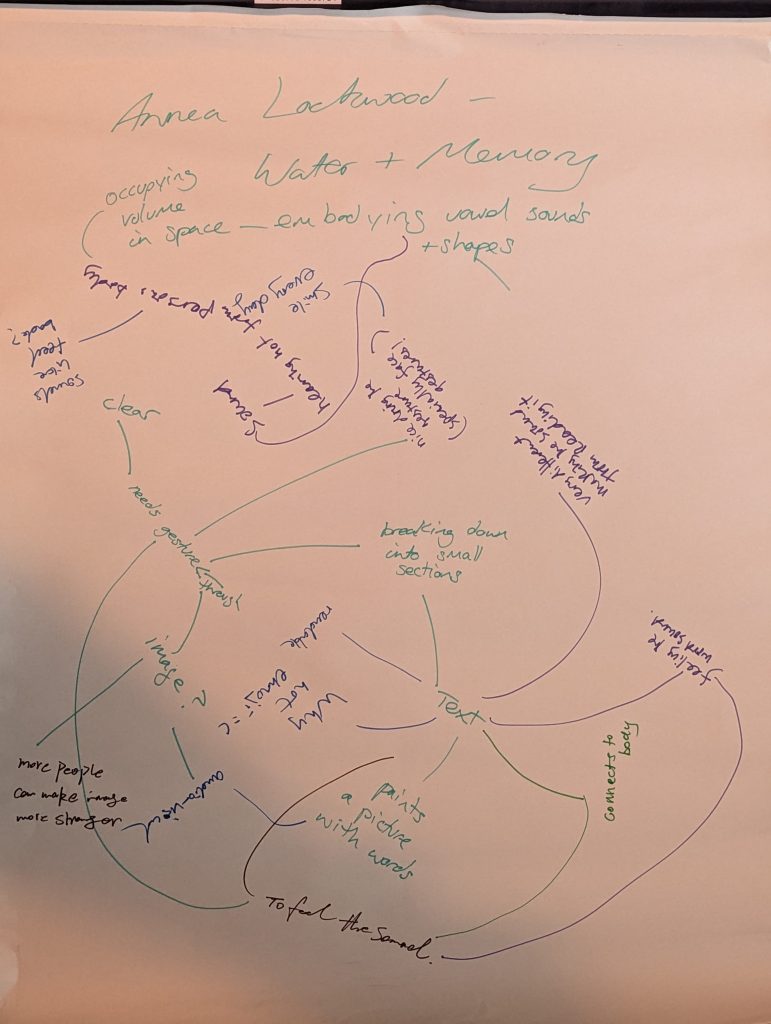
6 participants were present for the first Vocal Workshop, where the score by Annea Lockwood formed the basis for our discussion. I prompted participants verbally by asking them what had been accessible and worked well for them in the score: the incorporation of gesture and the use of text in the score rather than music notation. I gave them different coloured pens and a large fly chart. When working on vocals exercises and on the score we had formed a circle to disrupt the hierarchy of taught structure of traditional vocal workshops where one teacher is on one side of the room with students on the other, so we continued in this circle seated on the floor around the paper, writing as we discussed and linking our points together as a collective mind map.
Reflecting and refining
This worked well as a first exploration into gaining the insights of participants based on working with a specific score, with the aim of incorporating these points into the card deck of prompts for composers in workshop 3. However, I was aware of the gear shift required to go from a very internal practice of using the body and the voice, to being able to externalise this in words.
“In other words, while making music, the feeling and sound of the music takes precedence over the critical analysis, just as an inquiry does not begin with a research method in mind but begins with a research purpose and question.”
– Handbook of Arts-Based Research, edited by Patricia Leavy, Guilford Publications, 2017, p.237
This is part of a familiar barrier in teaching Sound based practice. Within a college that is focussed on visual arts I work in a department that works with the invisible art of sound, and the parameters applied across the university often do not fit the form of art created in Sound and Music. Working with the voice as a creative practice for over 30 years, I am familiar with the obstacles in verbalising a physical sensation, and an intangible process from the mind internalising information and transforming it to physiologically forming sound, then again forming this sounding and physiological response into a cerebral analysis and verbalising this.
Findings
How can I facilitate participants to form words and questions from my prompts to collect data in a practice that is internal and invisible? I found that the change from vocal workshop exercises to data collection mind map felt too academic for the co curricular space, and that as students and staff participated, students seemed shy in verbalising their experience in front of the ‘experts’. In our group tutorial, I posed this challenge within the construct of the Wise Crowds activity, an element of the Liberating Structure “Together, a group can outperform the expert!” (https://www.liberatingstructures.com/13-wise-crowds/#:~:text=Including%20and%20Unleashing%20Everyone,Martin%20Buber). The Wise Crowds structure allows a collective wisdom to be formed beyond the scope of the individual leader, and this fits with my motivation in teaching (see Rationale post https://pgcertiplum.myblog.arts.ac.uk/2023/11/08/rationale/).
I received the suggestions from my group and wrote the following notes:
Punctuation in sessions – moving, shift lighting, going from one section to another – a break to separate mind sets – give space to reflect on what they’ve experienced – time to transition from internal to external.
Can I get responses from the participants through the exercise rather than after, not written – Emojis, hand gestures, choice to take to next bit of activity or that I collect.
Would multiple choice be a stepping stone to forming words?
Recording of answers – not a comfortable process for participants in a vocal workshop, but could I create an activity out of forming words, where we form a soundscape made of the words we feel respond to the questions I pose? – (I thought of this after receiving feedback, as it made me think of my previous work with the NHS, see Data Analysis post https://pgcertiplum.myblog.arts.ac.uk/2025/05/28/data-analysis/) or a version of the word-deleting activity for artist statements I’ve run before?
Important to consider why we are recording and what will we use it for?
Practice cards for participants to write on and create prompts.
Perhaps a game could be made where participants put supplied words together to form a sentence? something like: consider/text as a / body responsive/ call and answer. Or perhaps this could be the design of the card deck and I make a preliminary version and get participants to add to the sections?
Workshop 2 – Reflection
Session Plan Workshop 2:
For this workshop I brought in a Visiting Practitioner to gain their insights and feedback into ways of working with the voice in a group scenario, and in particular ways of generating text to describe the physical sensations when discussing the workshop for data collection purposes. Rubie Green is a vocalist and trans artist who is developing ways in which her own practice can deliver an inclusive strategy for trans and non binary voices. I asked Rubie because she works in non-academic spaces and I wanted to bring a non-academic co-faacilitator into the co curricular space, as the data collecting had felt like such a gear shoft in the previous session. I applied for SEEF funding to be able to bring Rubie into the session.
In our planning session we had a very productive discussion about the balance of invisibility and visibility for trans and non binary staff and students. Both visibility and invisibility are important fo non binary and trans participants. During my project for the Inclusive Practice unit I focussed on the visibility of tans and non binary students and myself as the only non binary or trans member of staff in the department, in order to create a stronger sense of community and connection between different years and courses. I had run previous project for International Women’s day as part of the event series I created called Bechdel. I dealt with a changing landscape , and a much more negative response to planning a workshop for IWD. This then led me to consider the importance of invisibility, as the need to create a safe space relies on a fundamental safety in which to be forming new identities, which in itself is a vulnerable time to become a focus for any potential backlash. We discussed this and the balance being found between visibility and invisibility by the nuance that can be done during delivery through language and choice of activities, and the visibility brought to the space through our own presence as non binary and trans facilitators and how we introduced ourselves.
I was looking forward to working with Rubie in delivering this workshop together, and I found an unexpected level in the feeling of safety and community myself in the sheer joy of working with someone else who identifies as non binary and trans. It was a revelation, and made me realise how little is needed in order to feel a sense of community, and how alone we can feel without realising until we have other people to work with who we feel aligned with in gender identities.
We ran several activities within the session, based on the ideas we discussed of game play as part of each activity and as part of the discussion activity. This definitely improved participants’ ability to verbalise a response when prompted. We did an activity which Rubie called ‘Exquisite Corpse” and is often also called ‘Paper Telephone”, where each person begins with a line of text they write before turning over the page to cover it, and they pass their page onto the next person to continue writing and so forth. In order to gain different aspects of their experience I asked them questions that were more abstracted and less directly about their own vocalising.
Prompts:
What voices are heard the most in group singing?
What do you need to do to make your voice heard?
What do you need to see in a score in order to feel able to use your voice?
What happens in your body when you want to use your voice but don’t feel able to?
What does your internal voice say when you are about to participate in group singing or sounding?
I asked them to respond to these prompts, in order to gain insights into themes around the voice, the different voices we hear and use, and the different ways in which we can facilitate the use of the voice as well as understand the obstructions in place for students and staff in using their voices. All the contributions involved equal participation,unlike the mind map from workshop 1, and it was anonymous, unlike workshop 1.
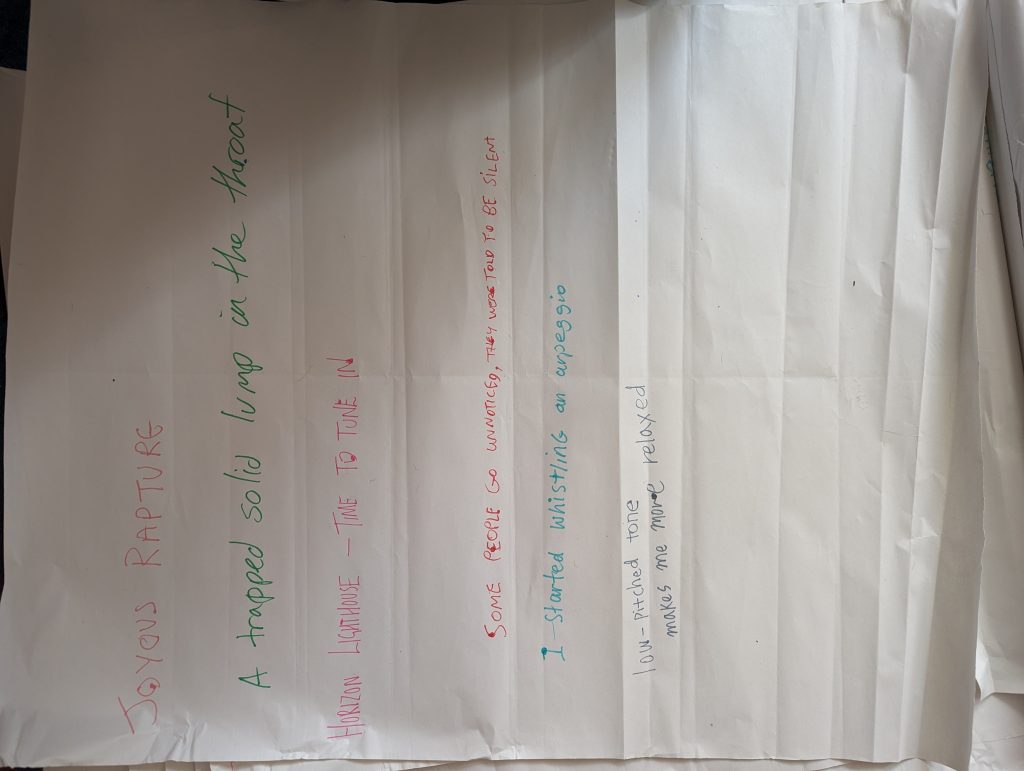
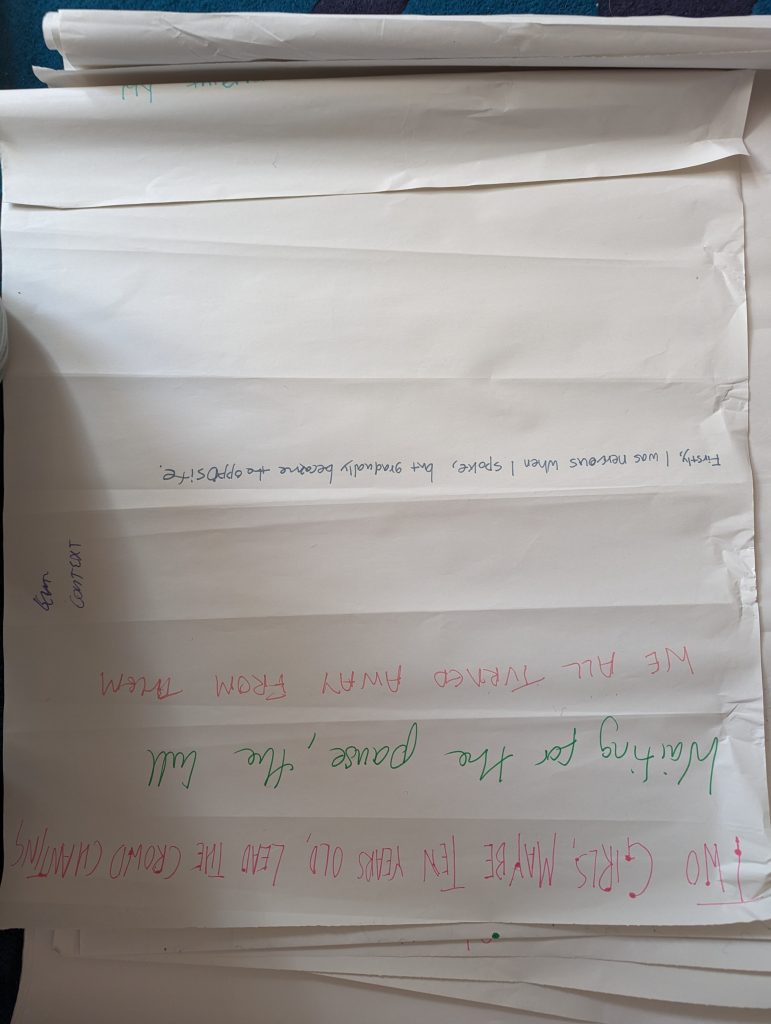
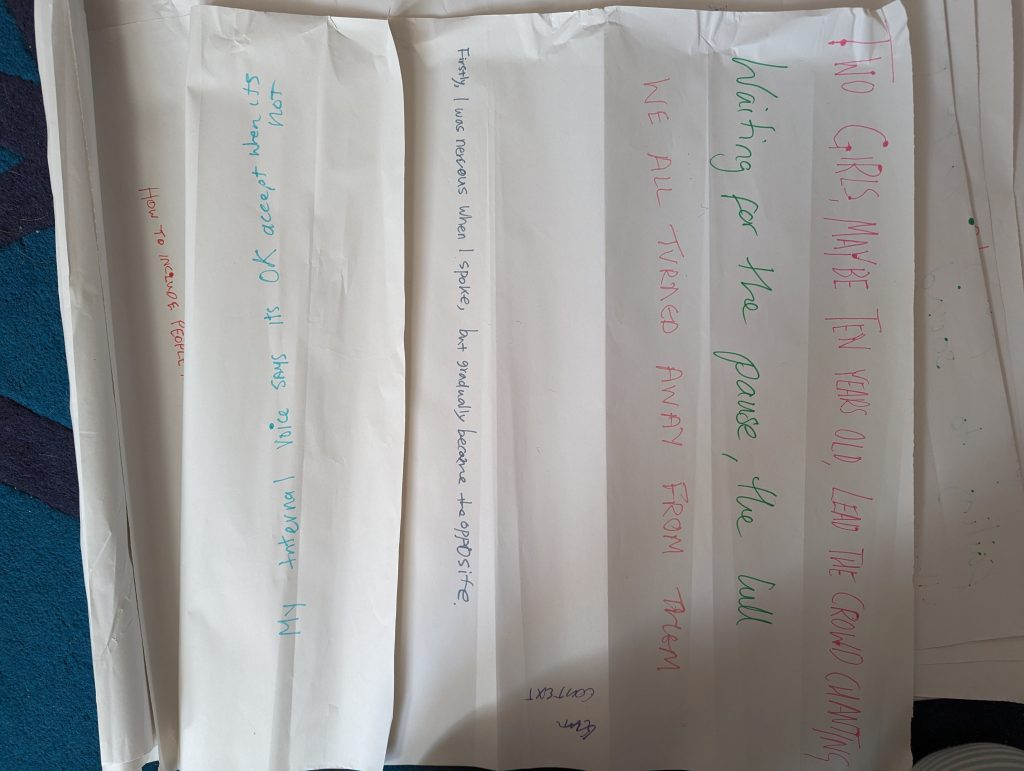
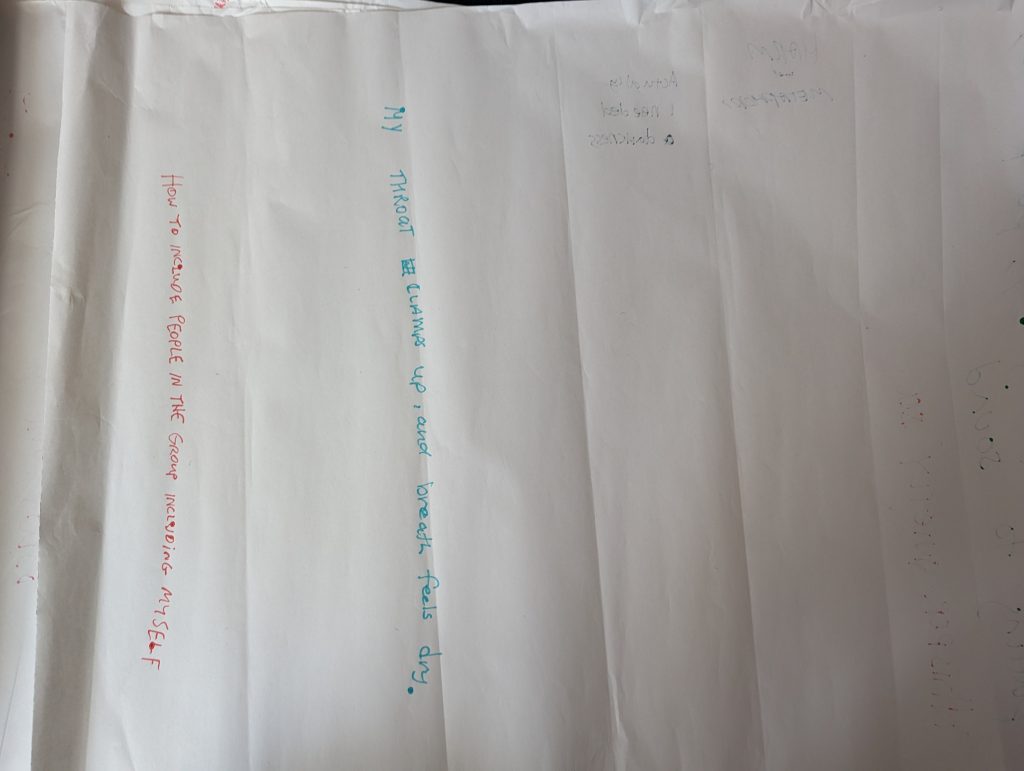
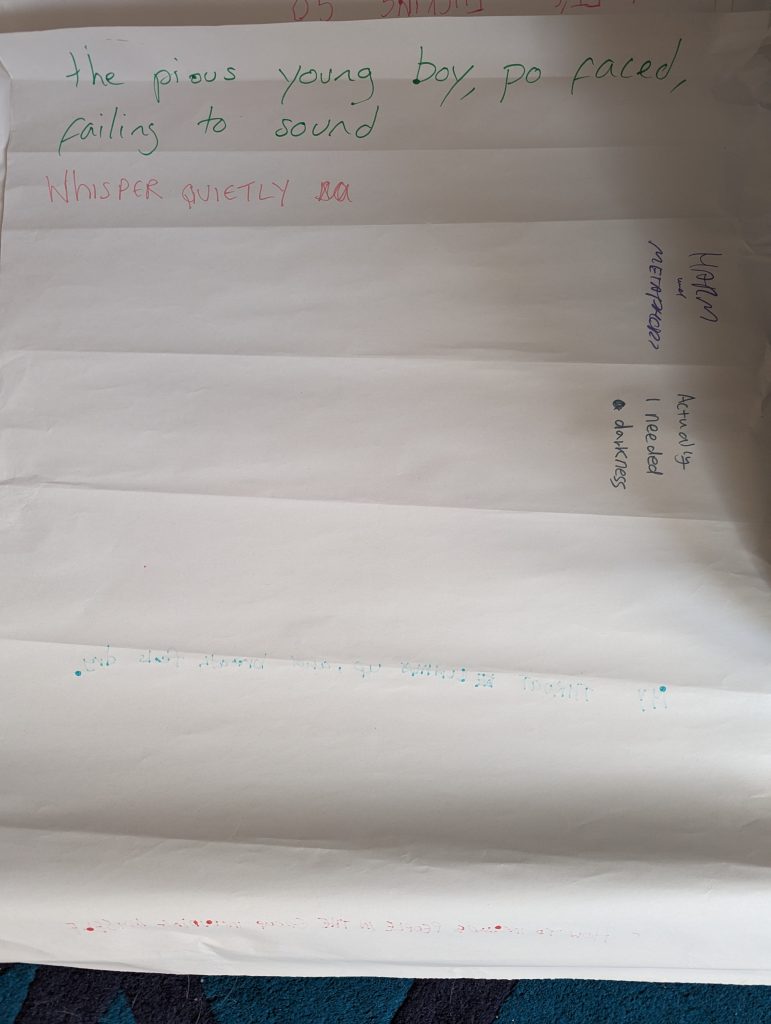
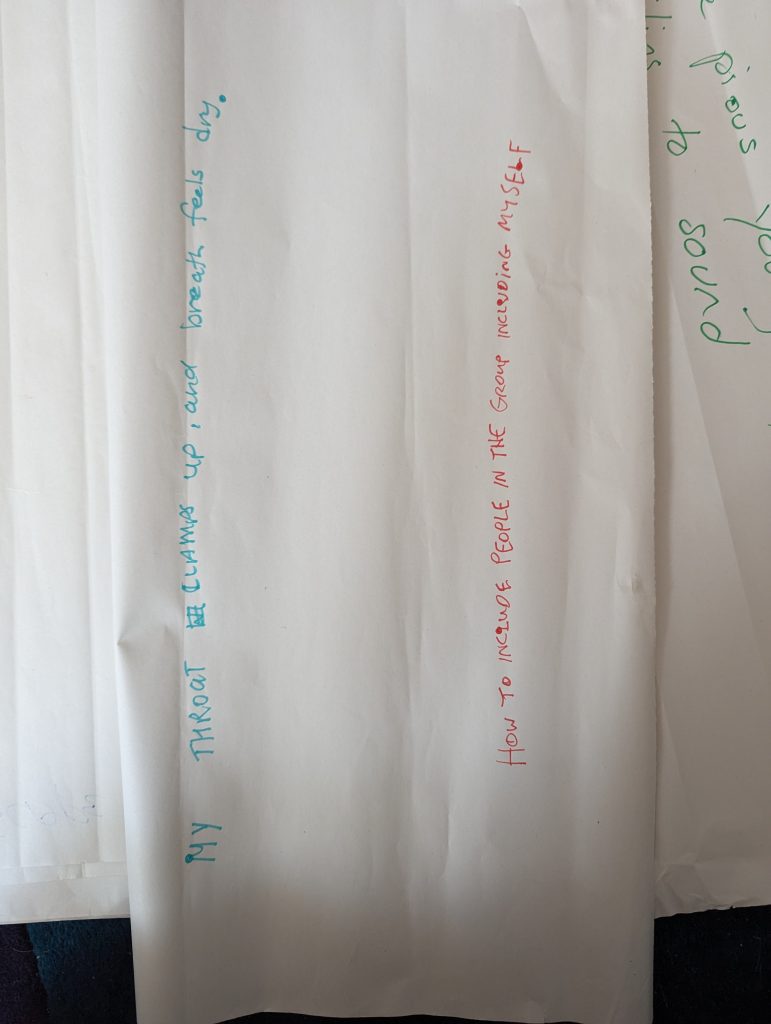
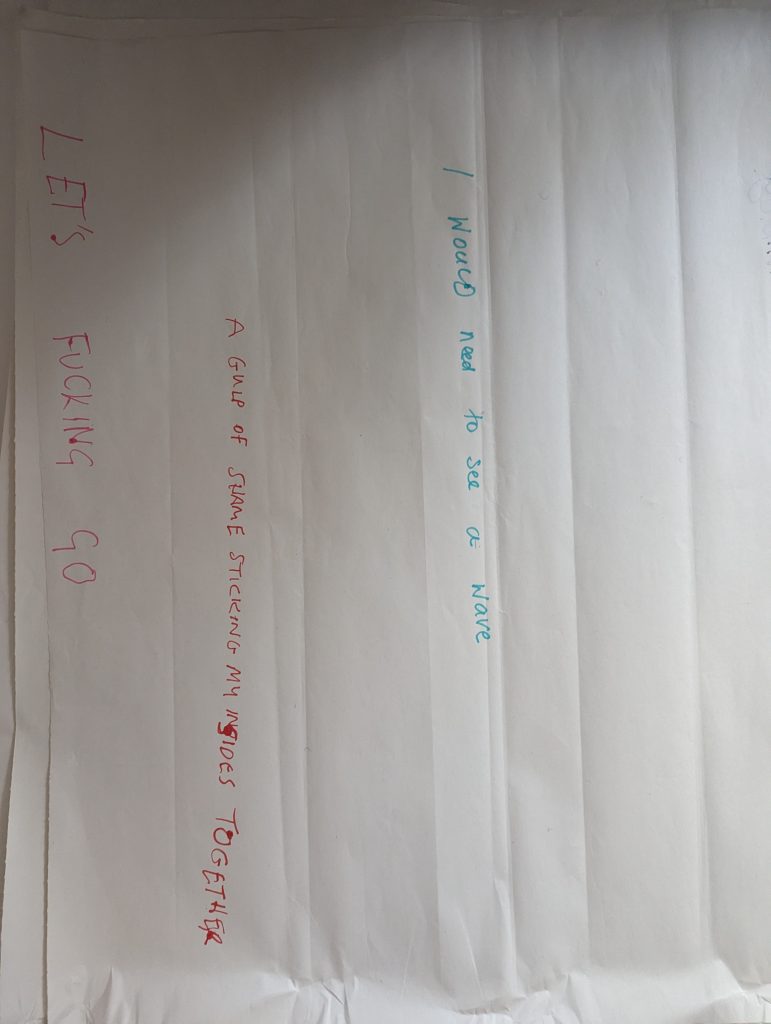
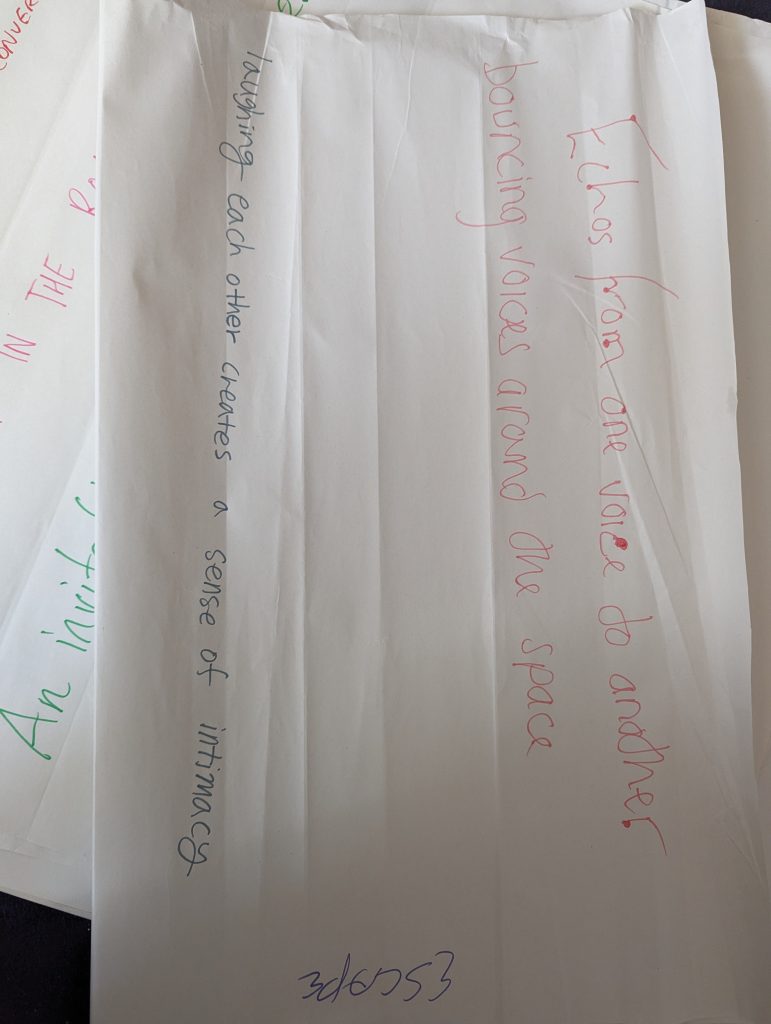

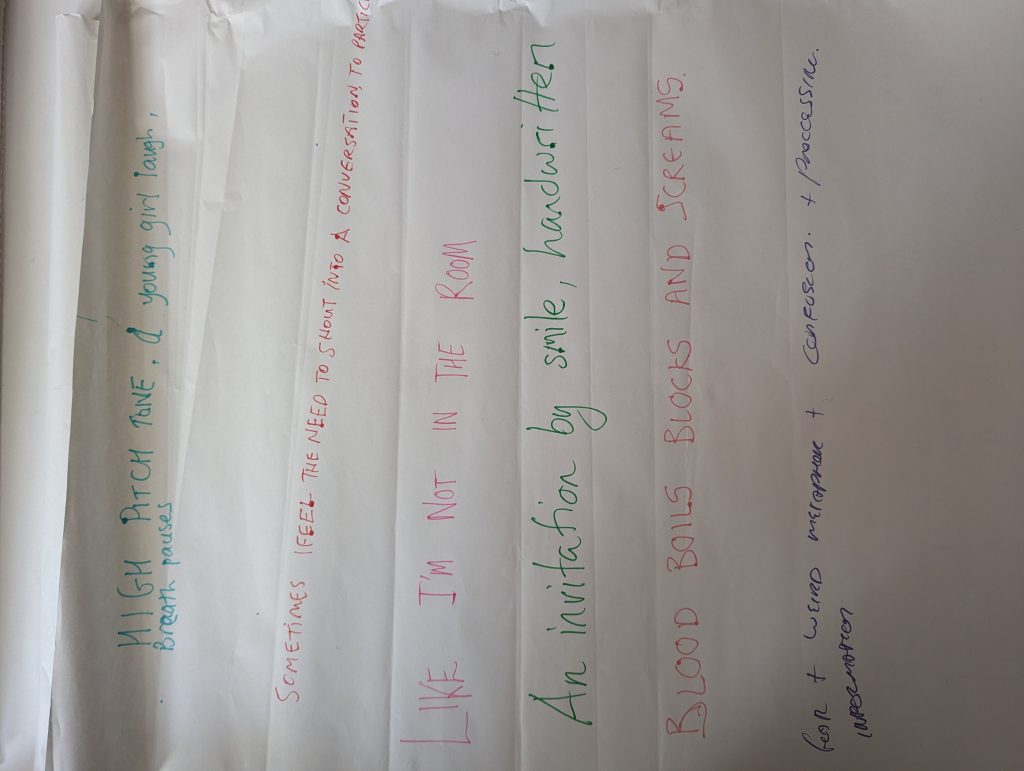
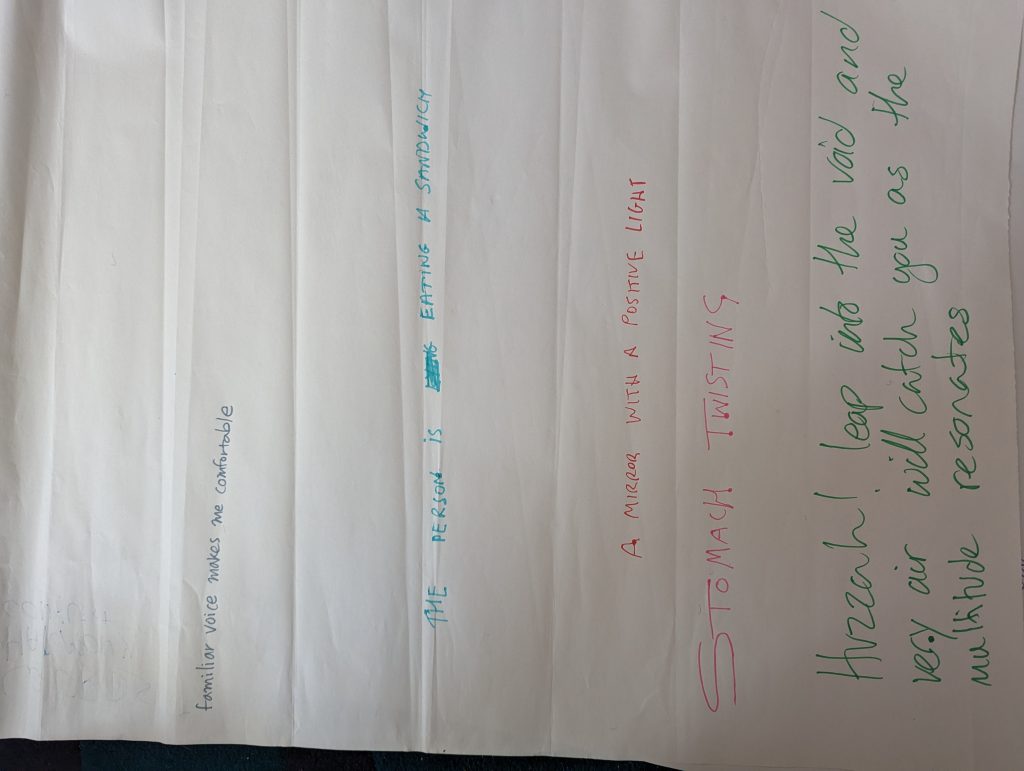
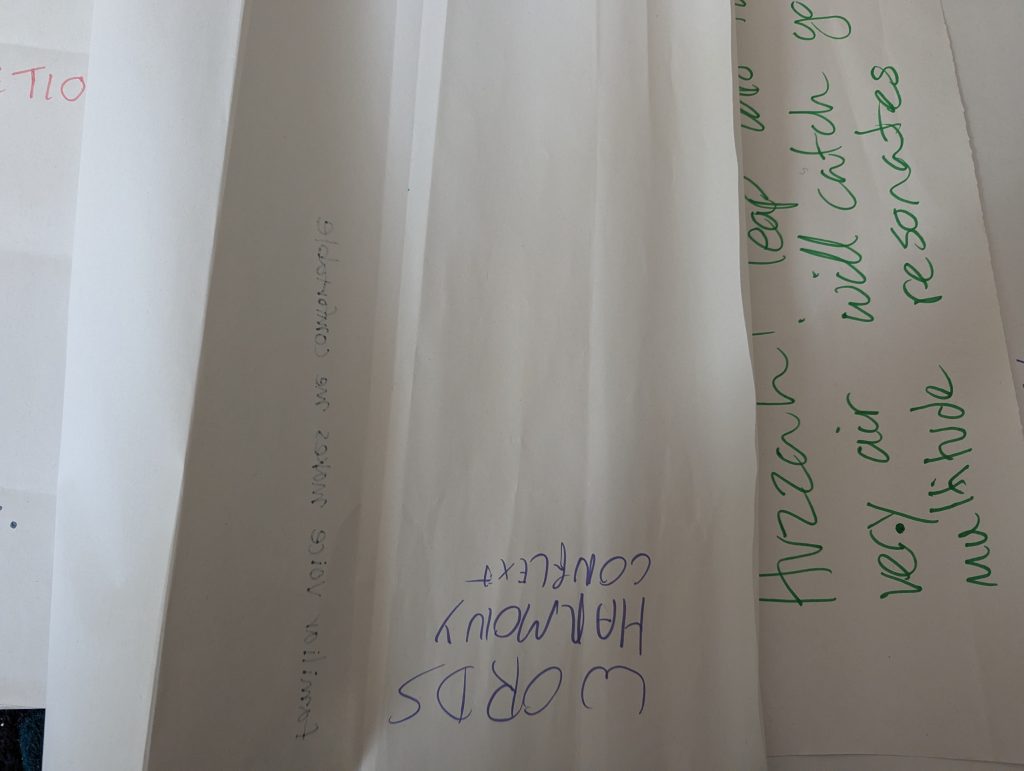
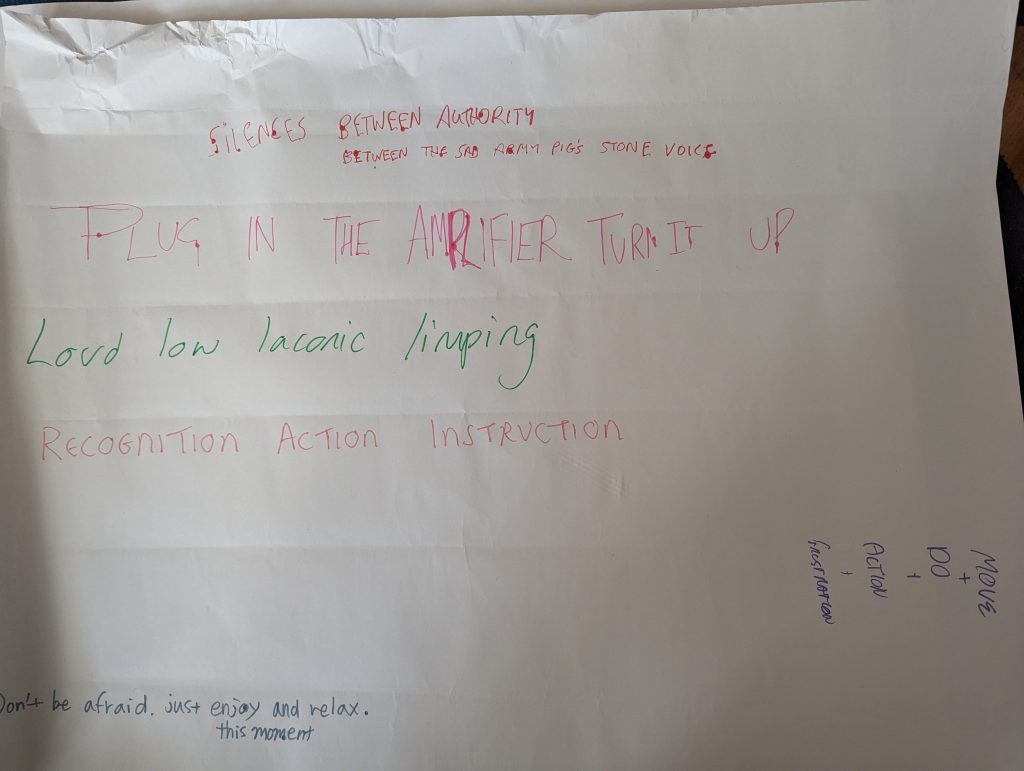
Workshop 3 – Reflection
Session Plan Workshop 3:
In the 3rd workshop, we worked with instructional scores, by Pauline Oliveros, and began to develop our own participatory instructional score. I suggested this take the form of the popular card decks, such as yoga decks, tarot decks and Sharon Gal’s Etudes (https://www.sharon-gal.com/etudes). I prompted participants to write an instructions that was accessible, directional, open to interpretation and descriptive.
My prompts took the form of a guided visualisation this time, using an internal art to access the internal processes of voicing. The visualisation asked participants to imagine an environment in which they feel able to explore and experiment with the voice. I then asked them to write a direction for vocalising, which would allow others to explore their voice in the way they were visualising. These instructions cards were designed to be drawn at random, and made anonymously, for the group to experiment with the directioons on each card.

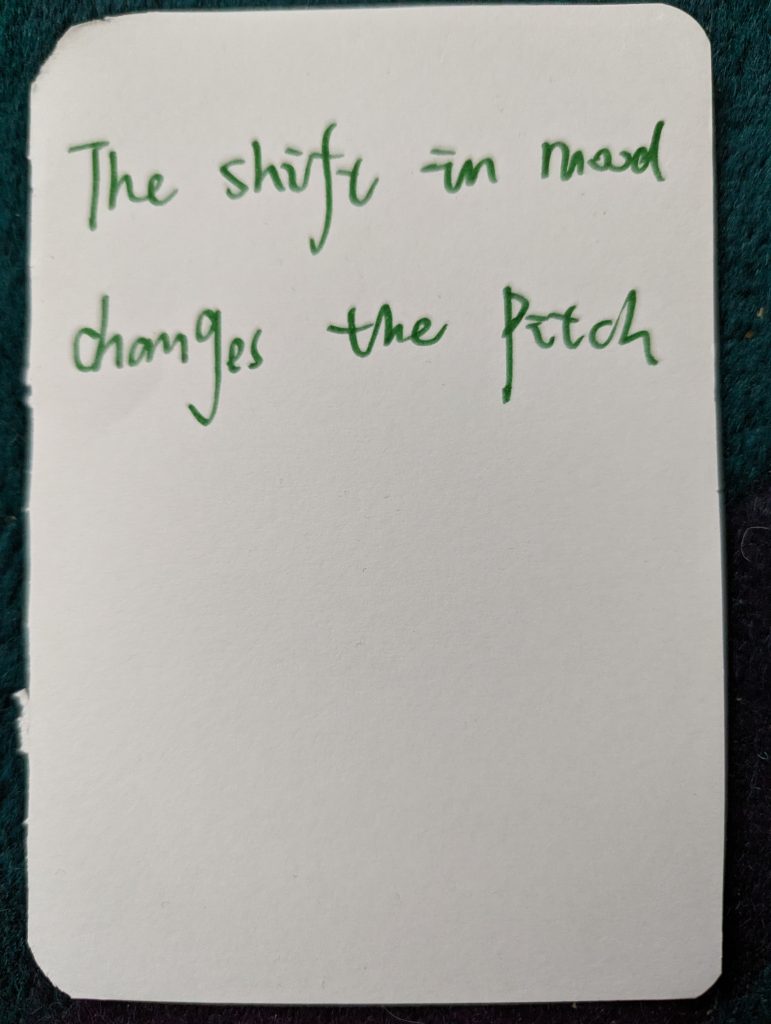

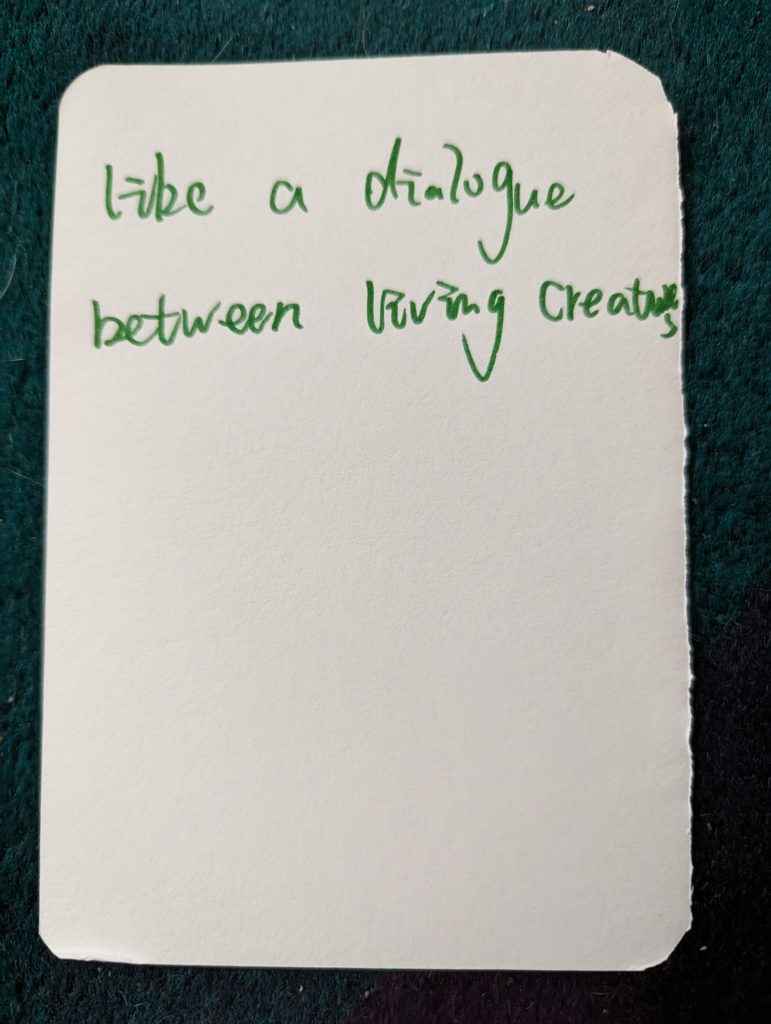
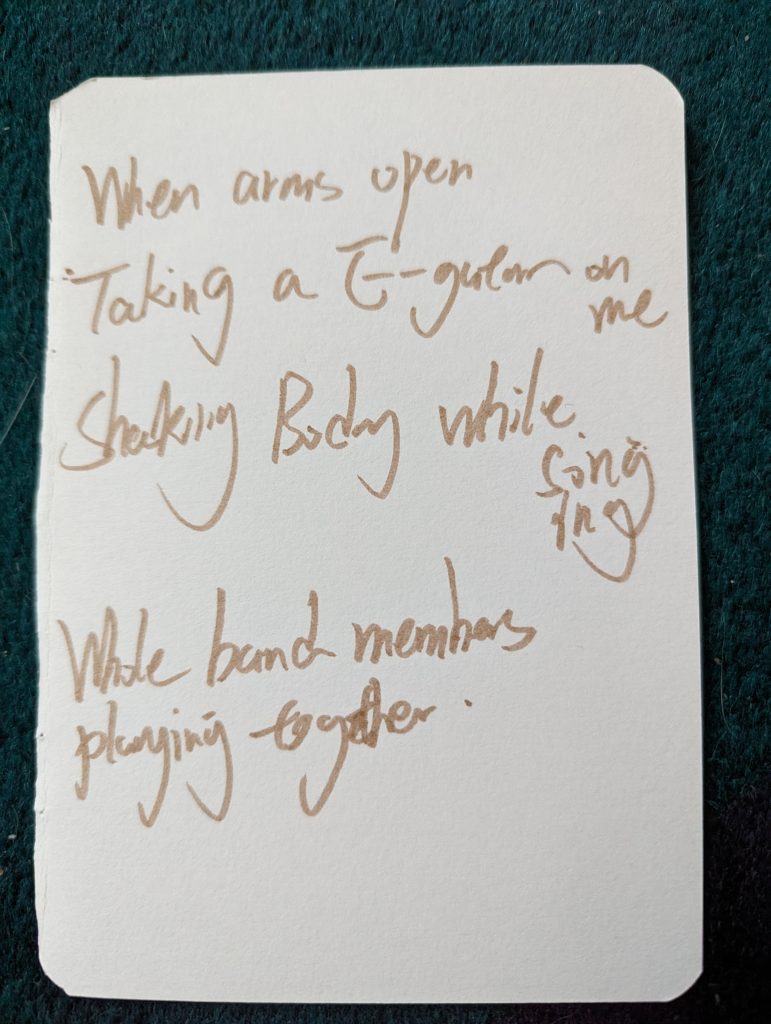
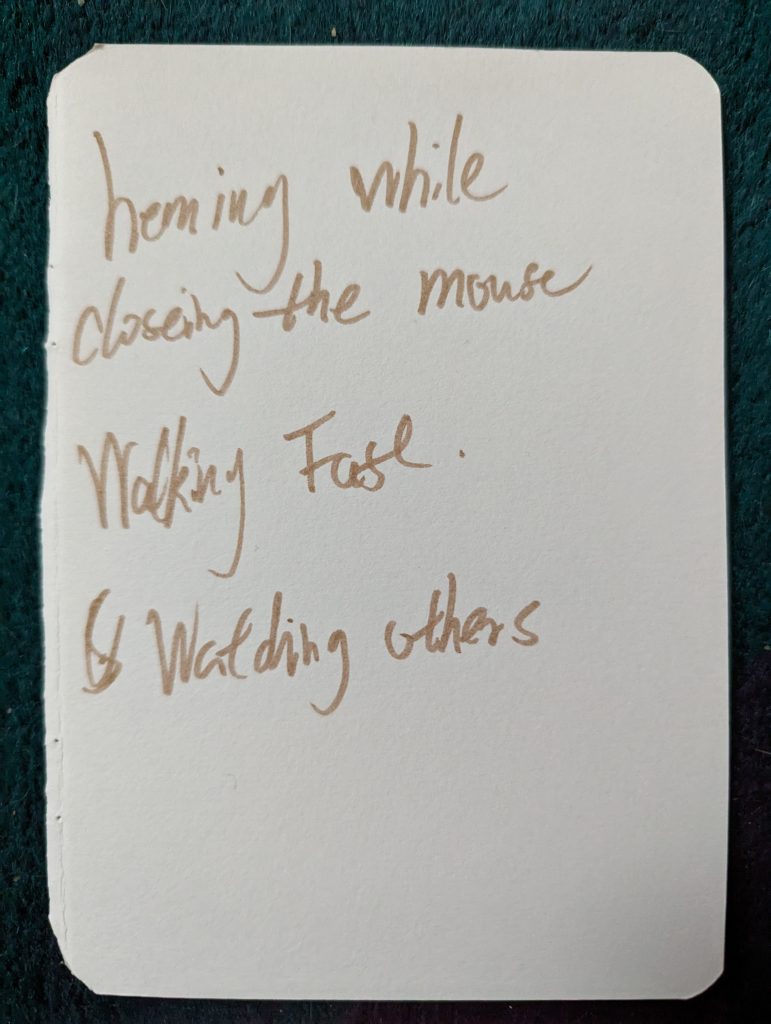

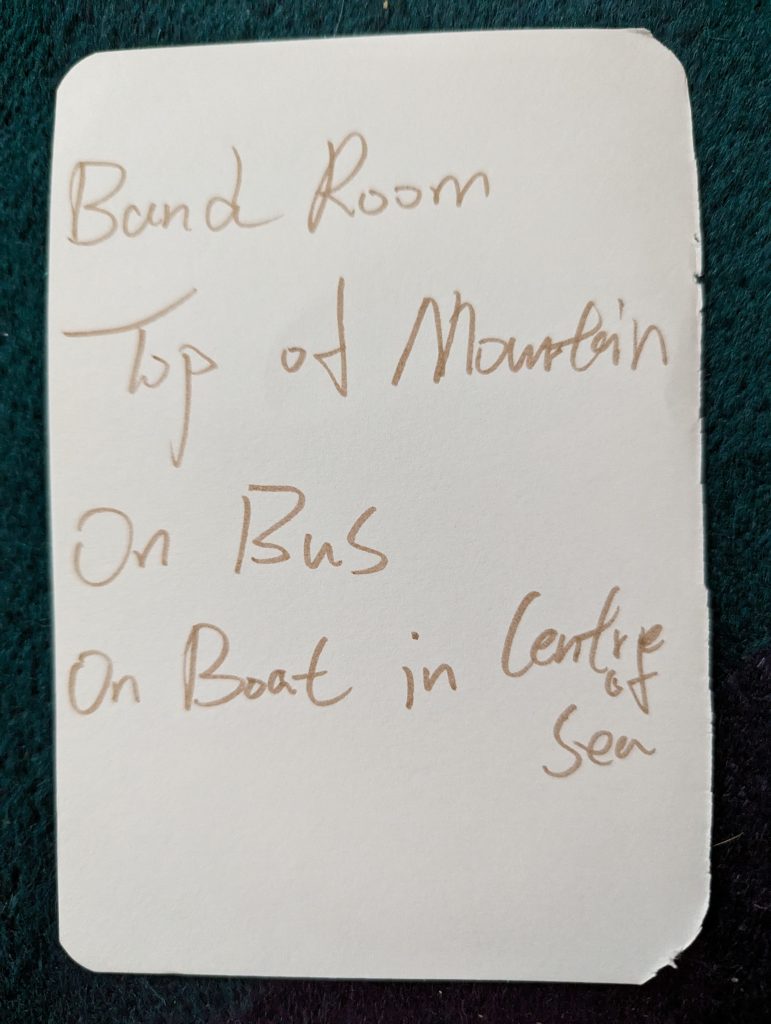
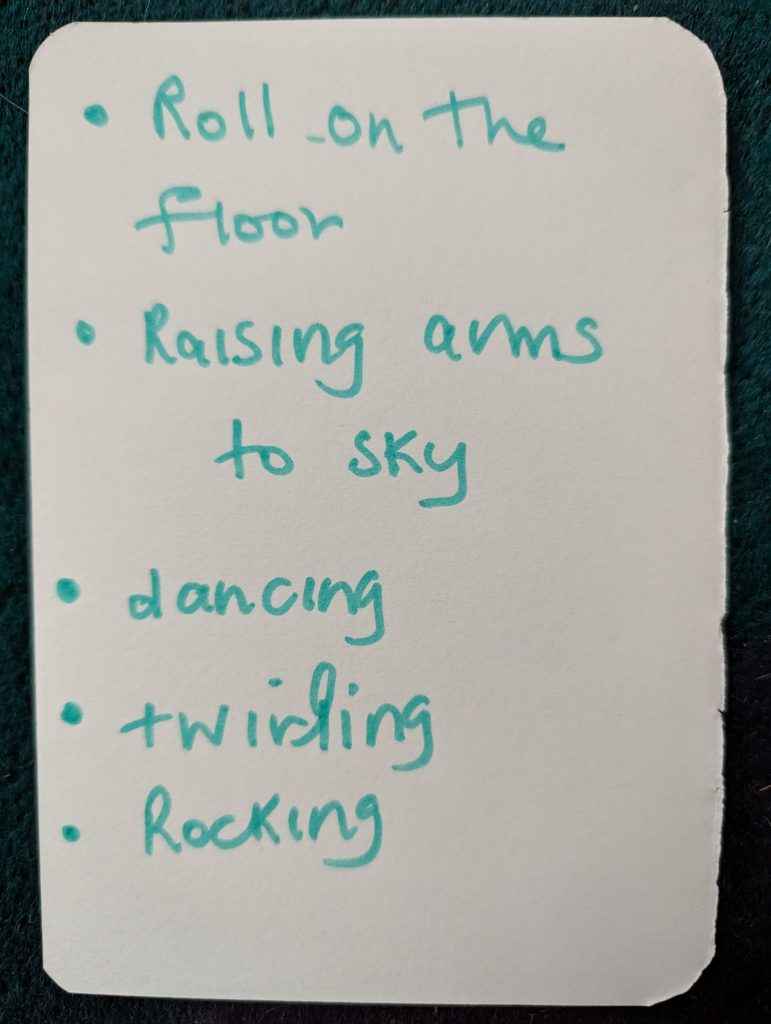
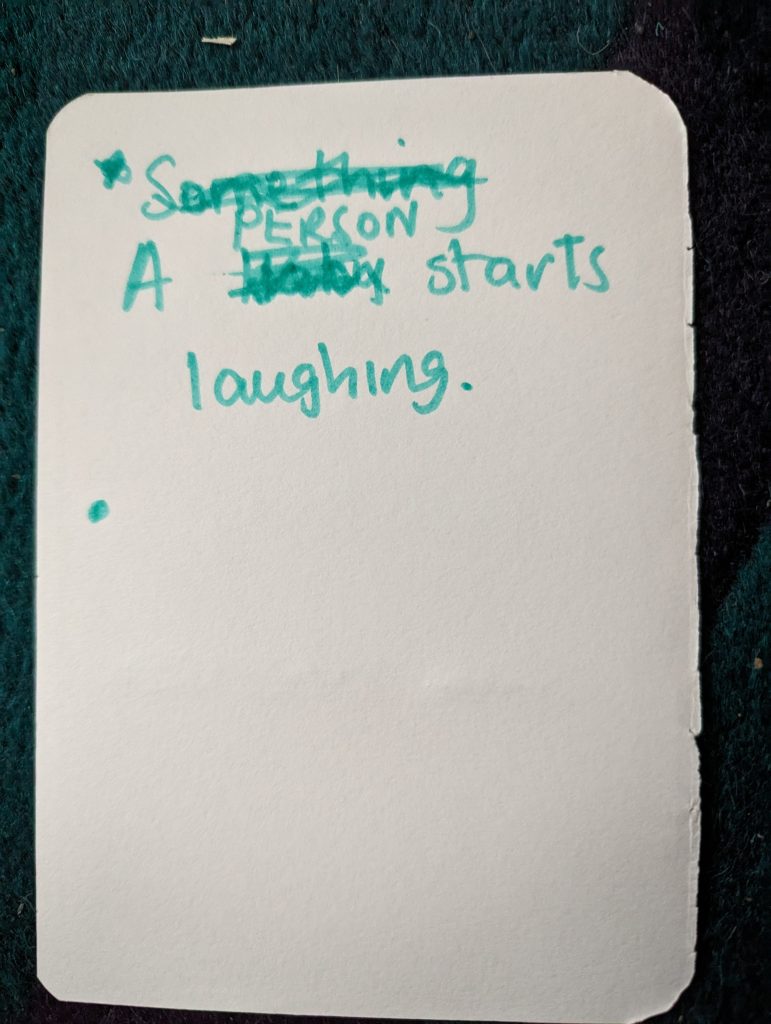
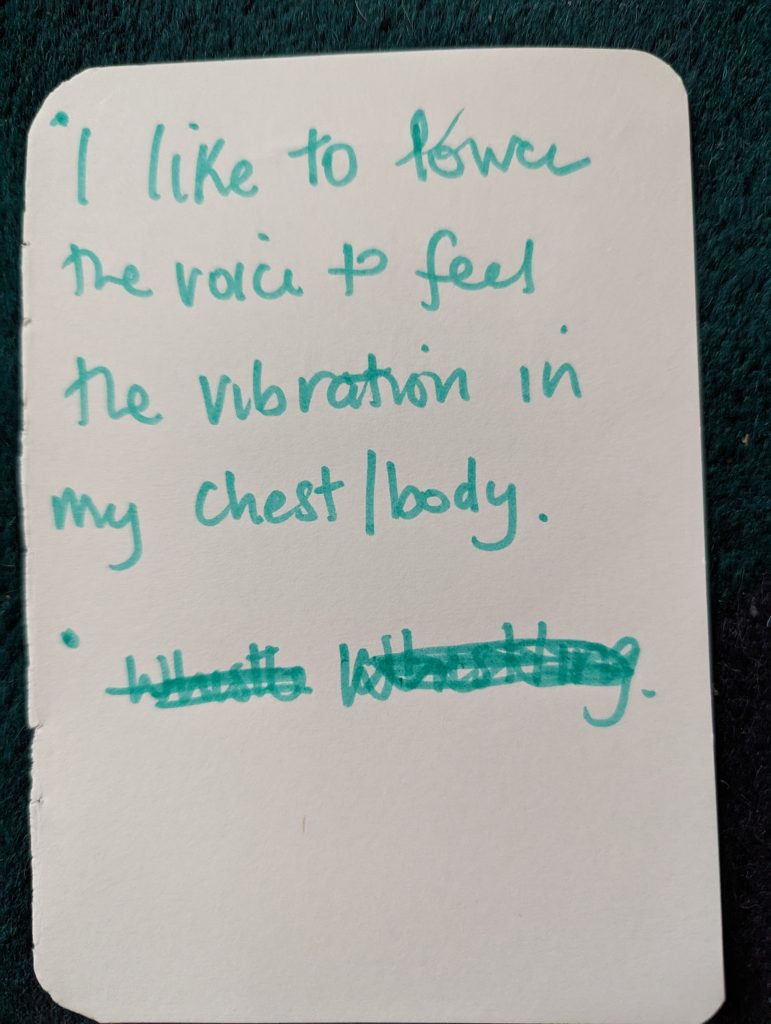

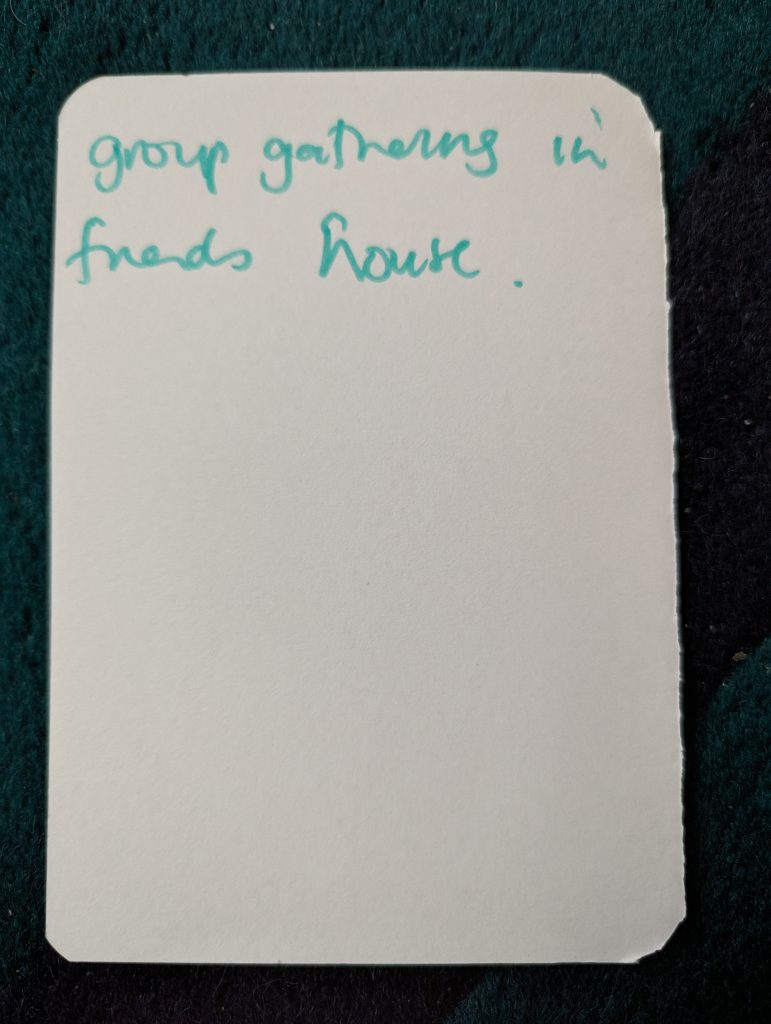
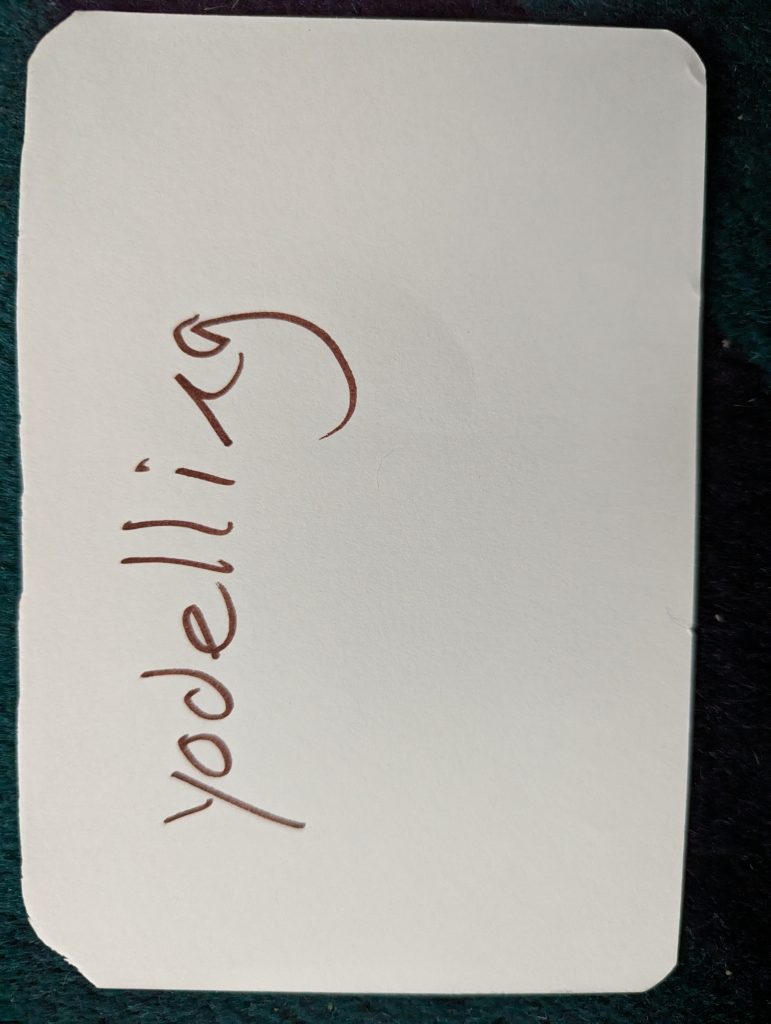
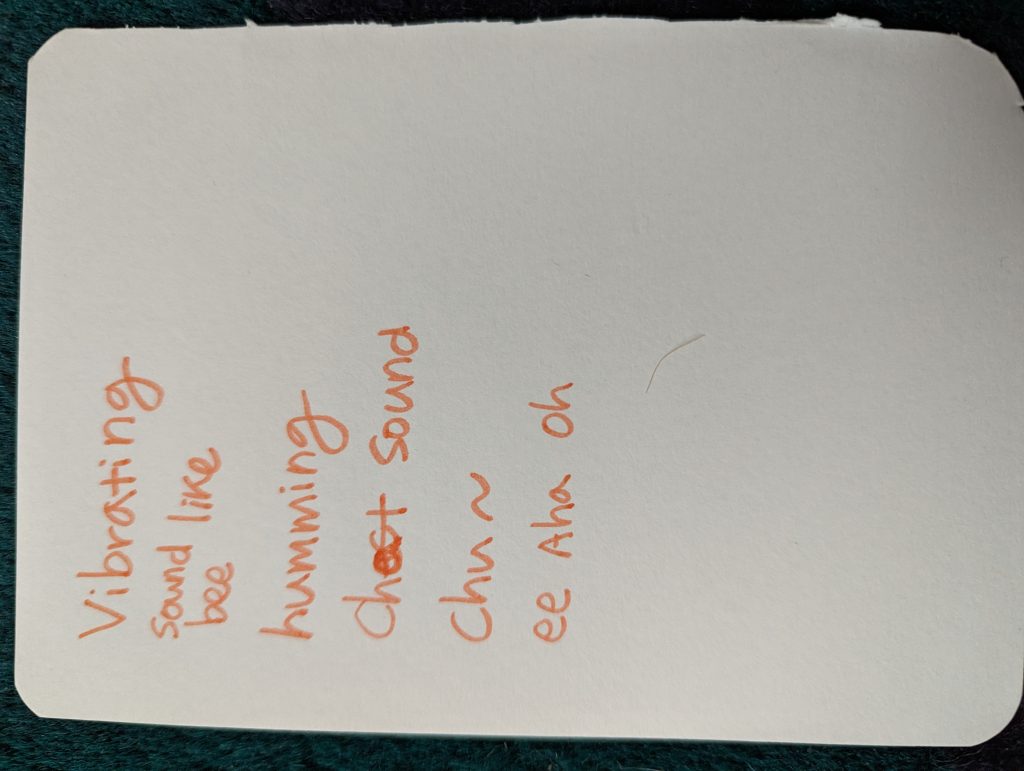
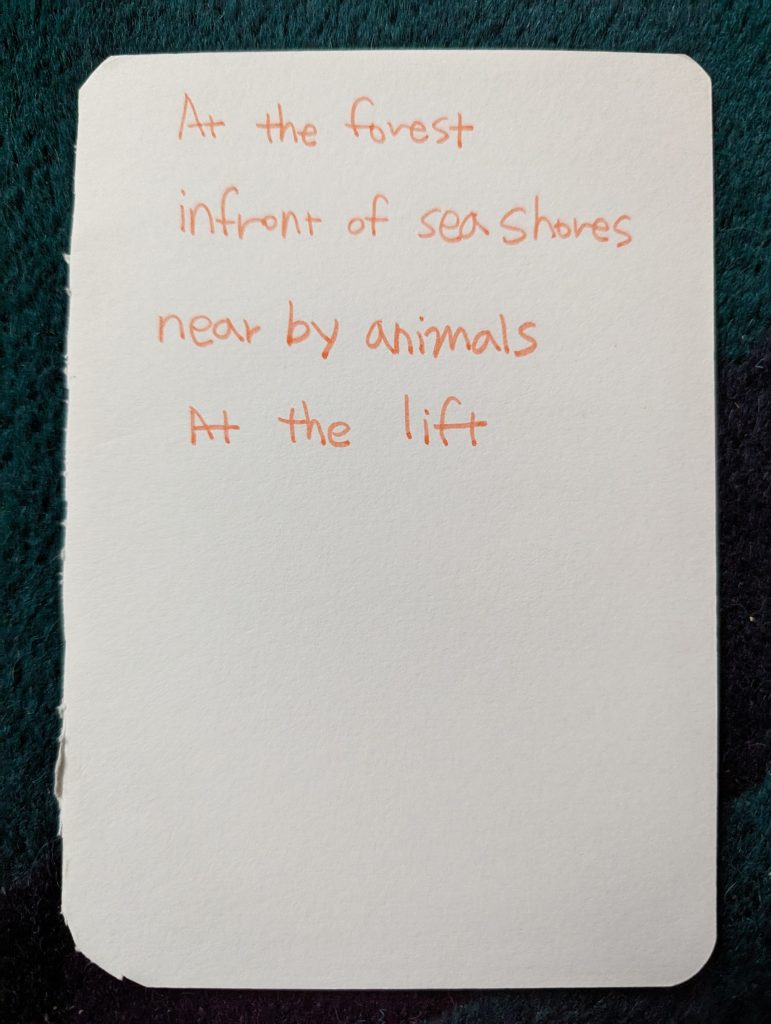
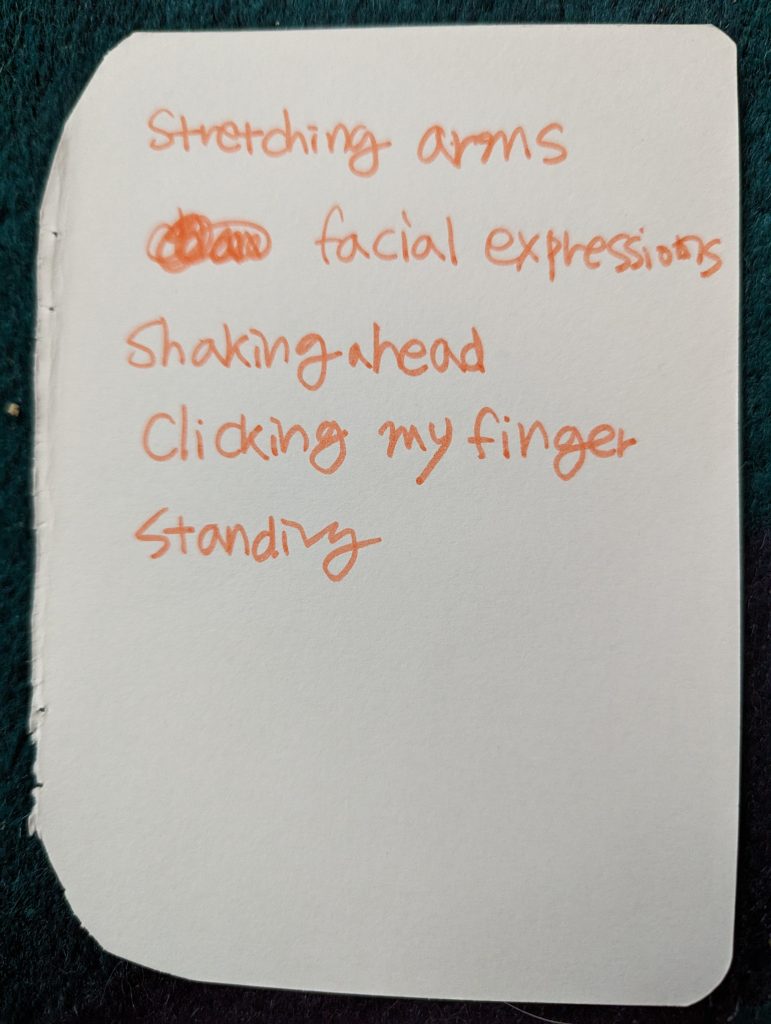
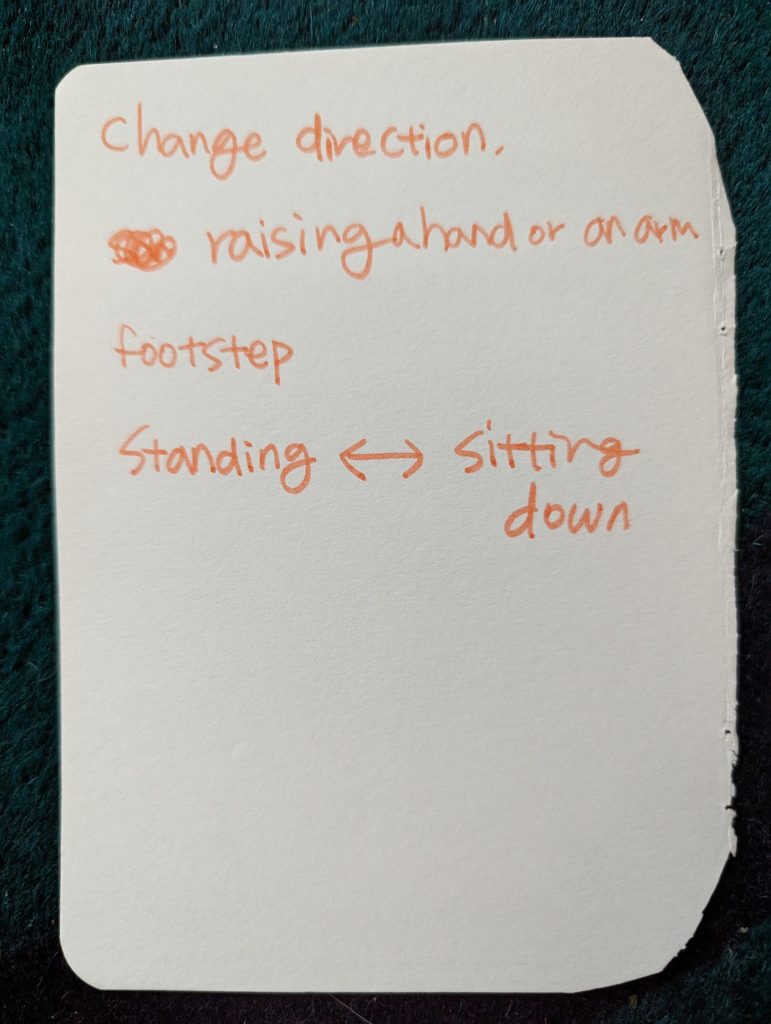
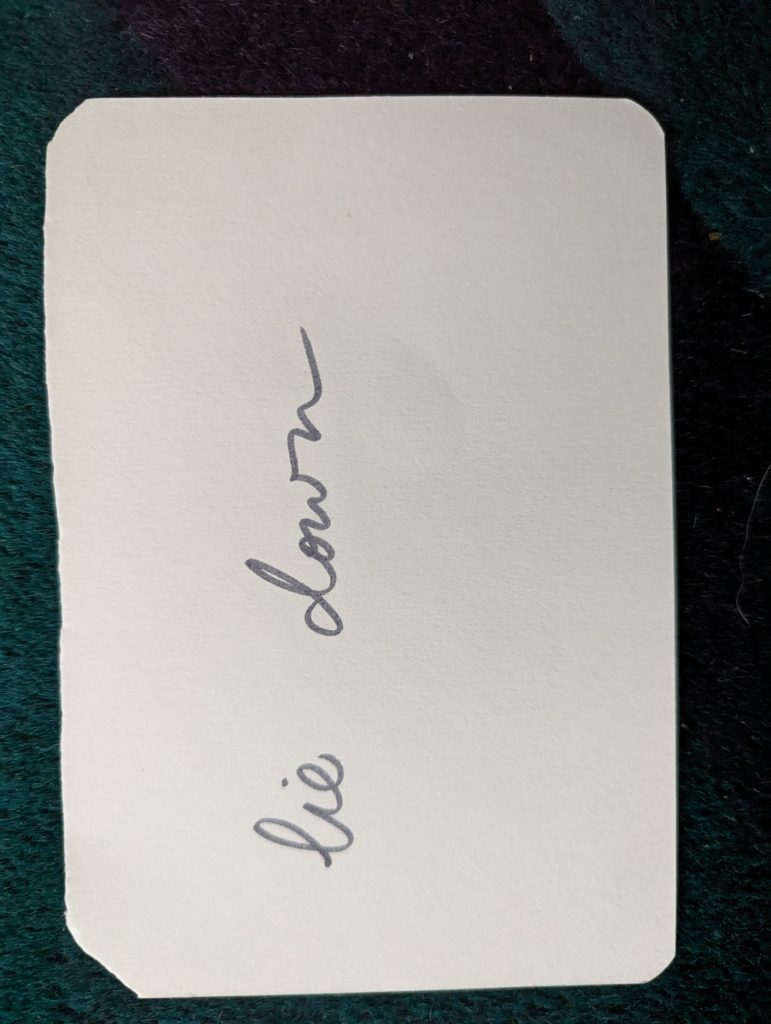
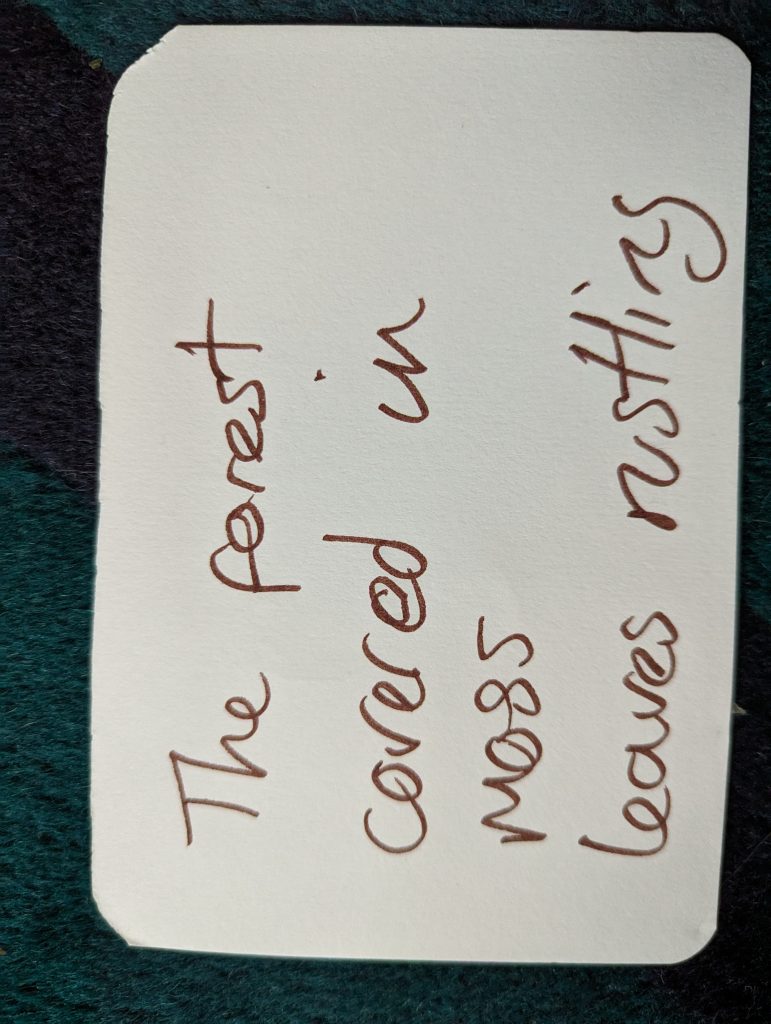
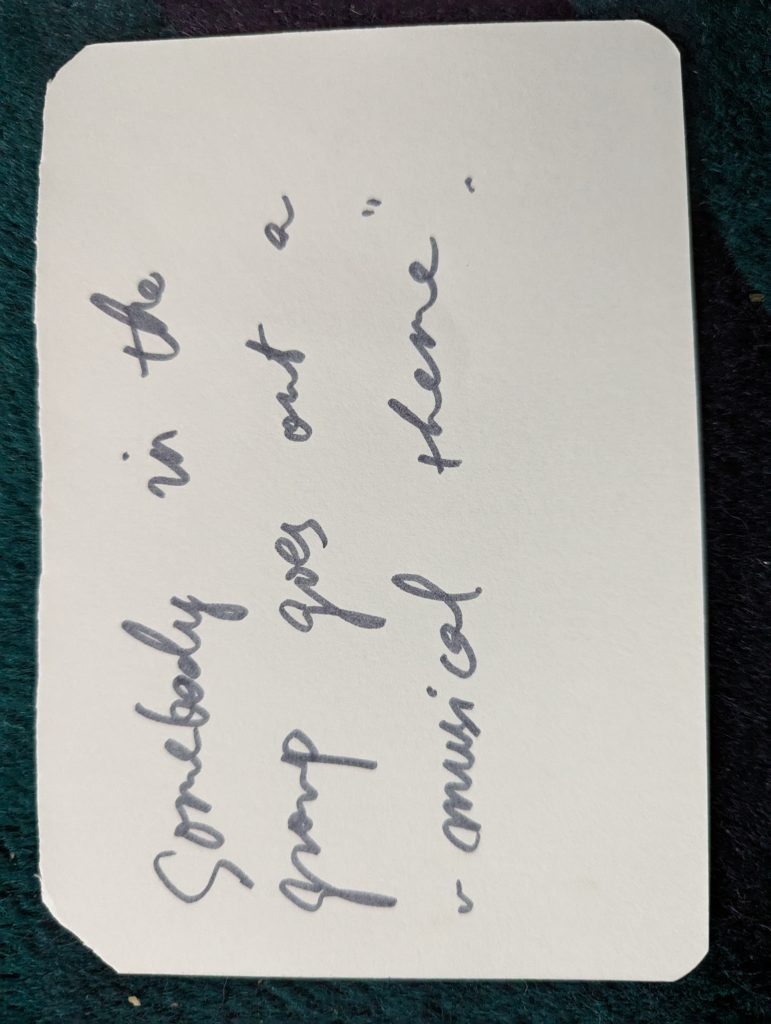
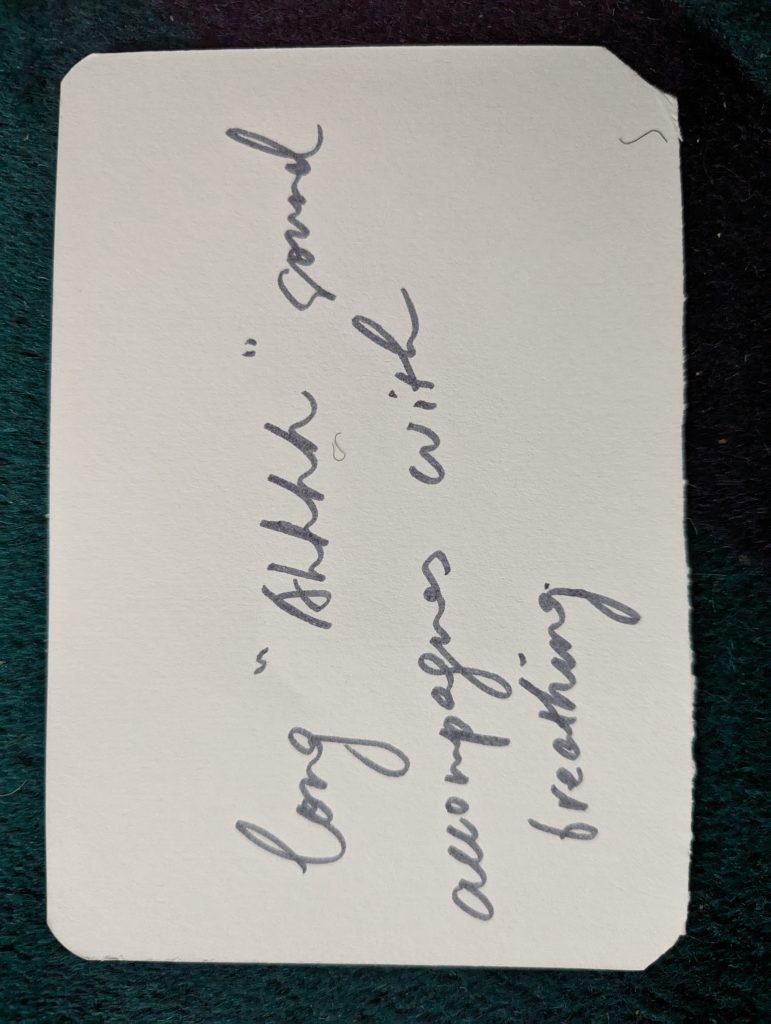
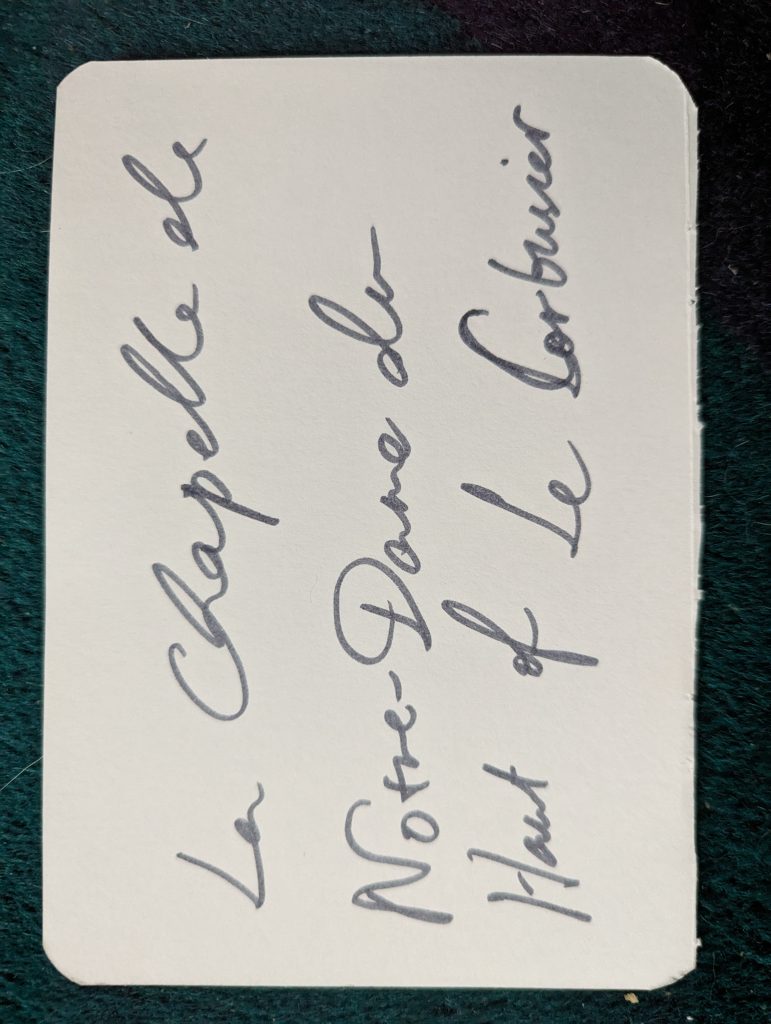
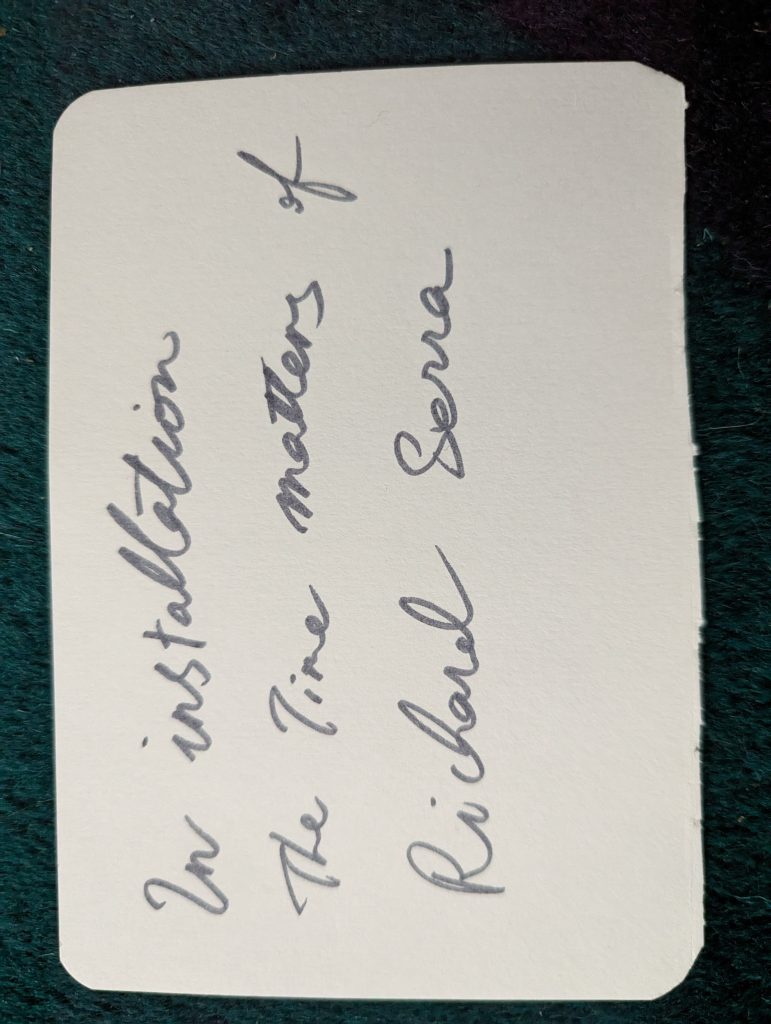
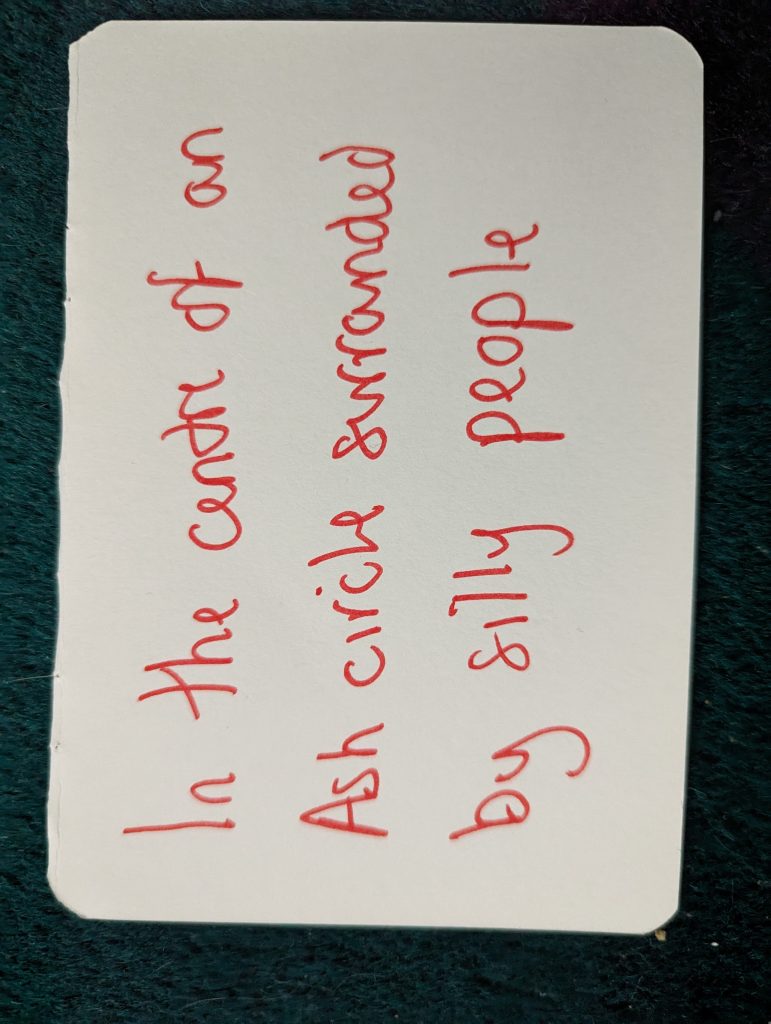
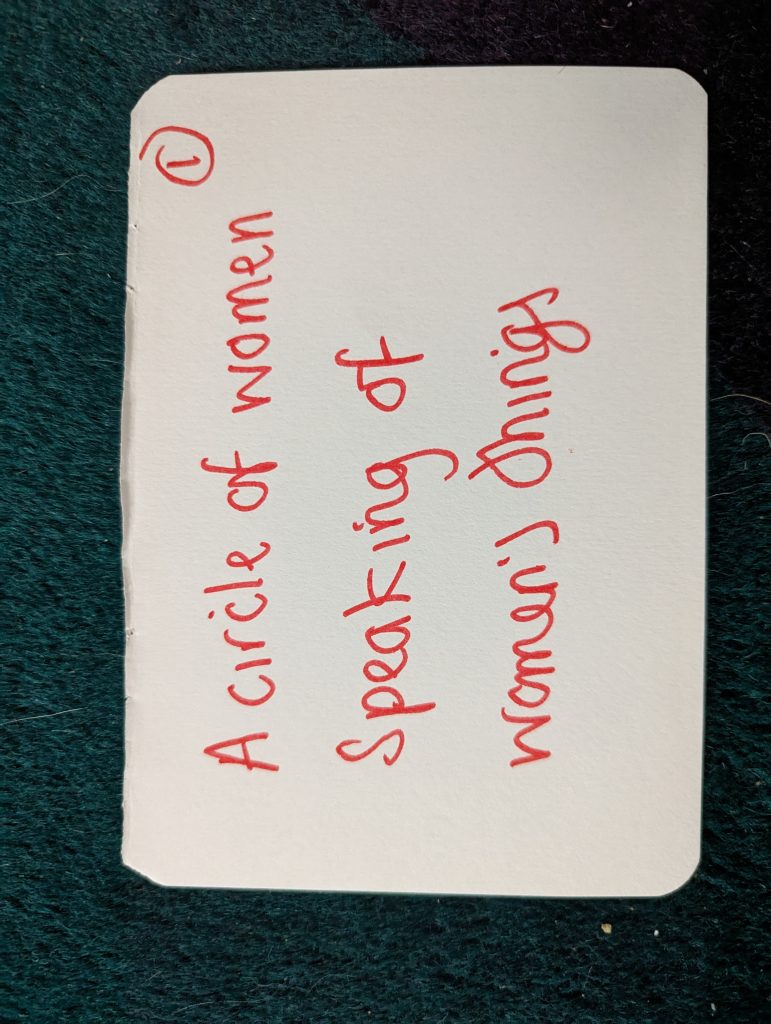


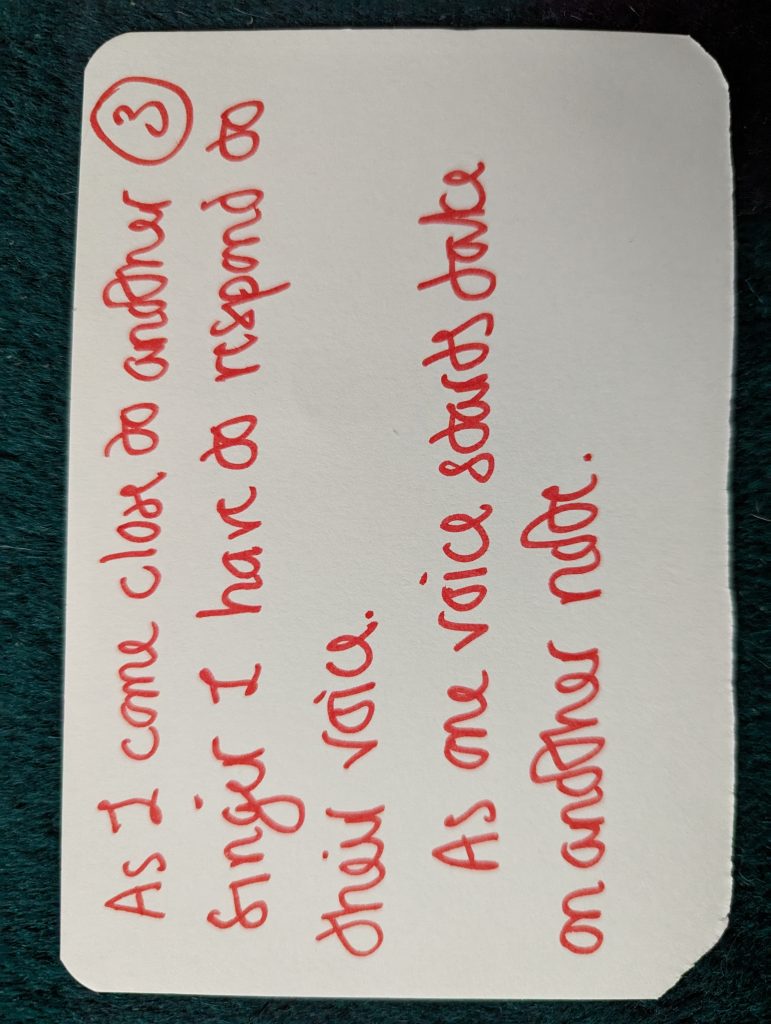
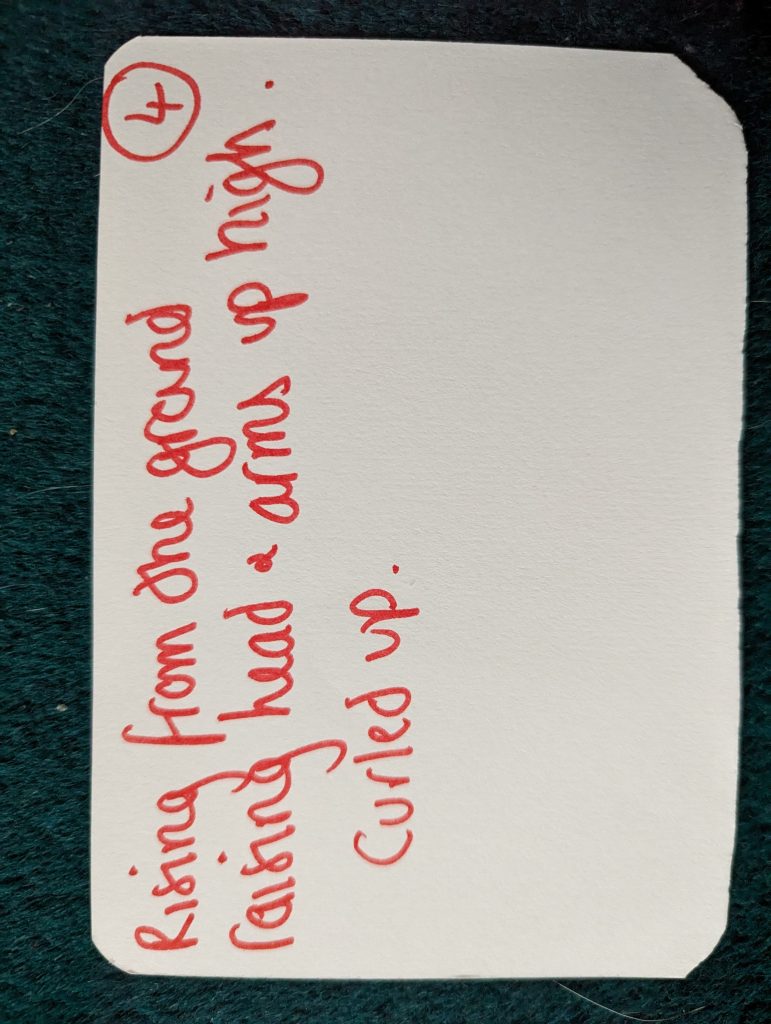
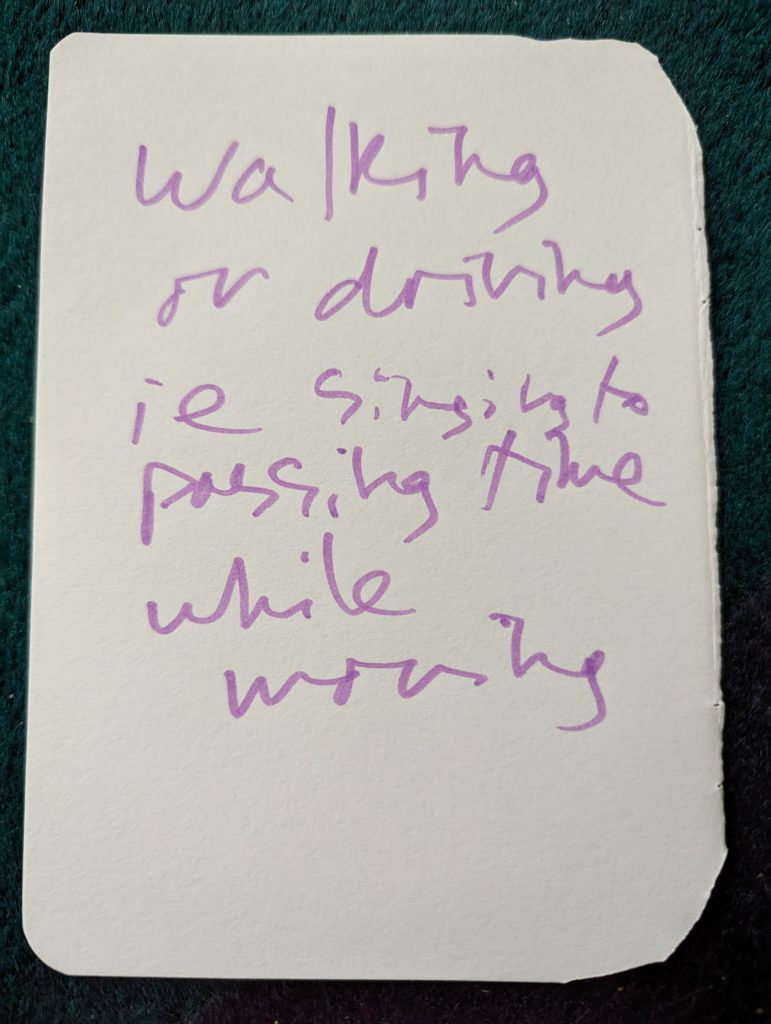
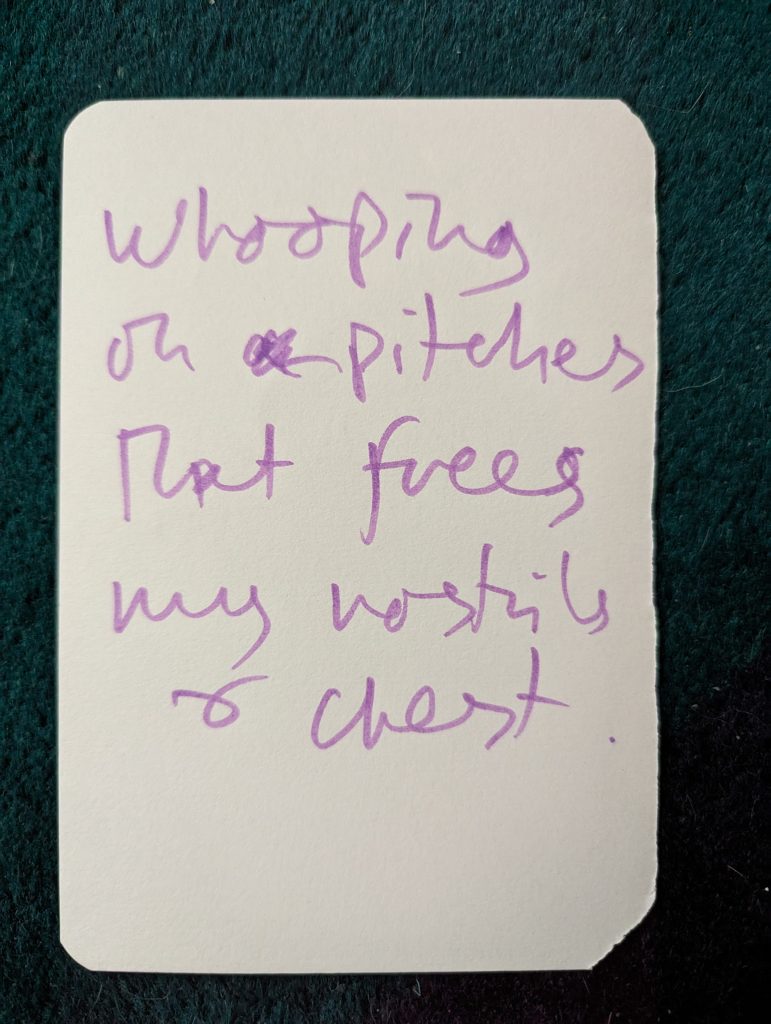
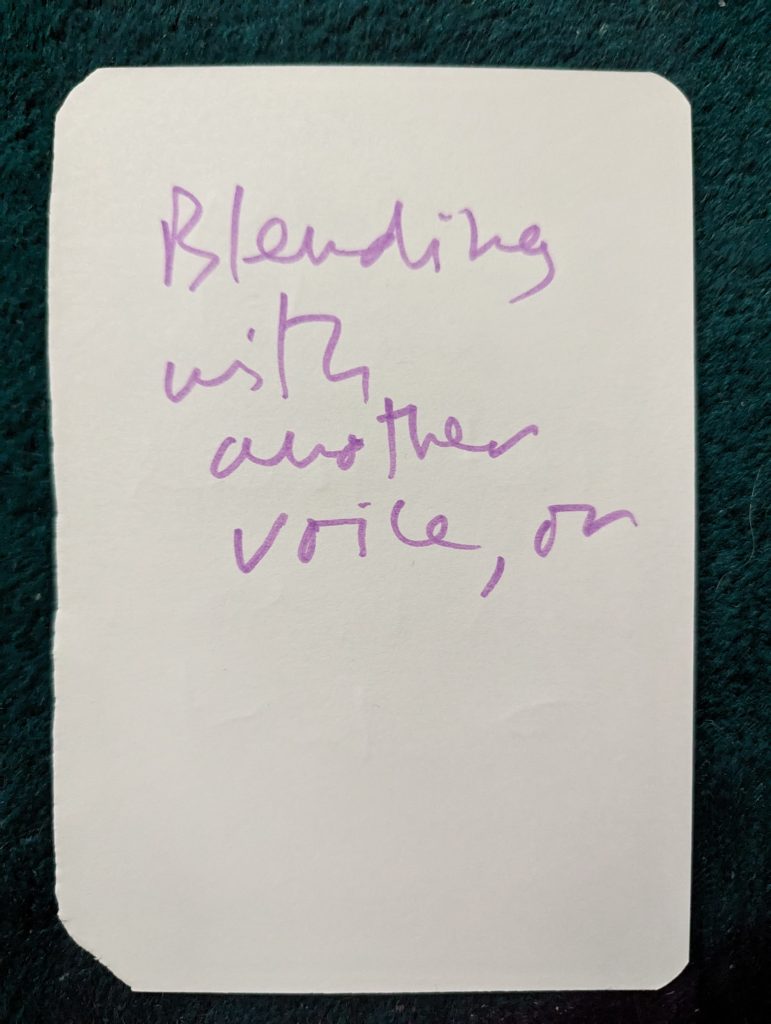
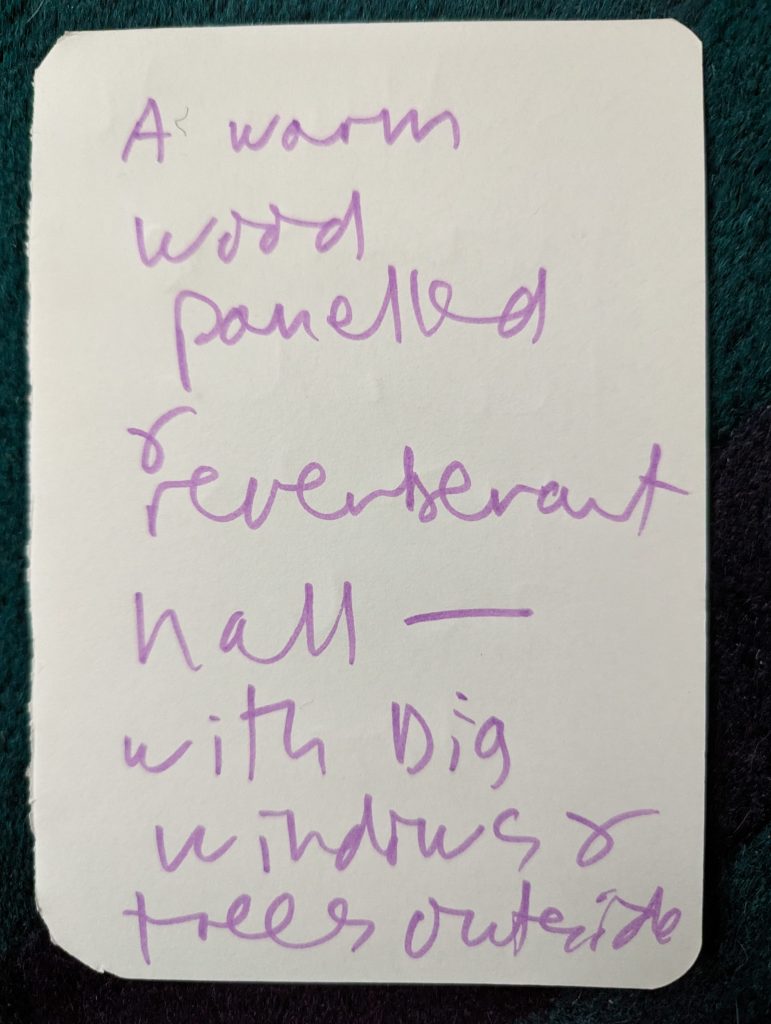
It was interesting to use a visualisation process to make the invisible verbalised, much of our language, even outside of visual arts, defaults to ‘seeing’. The visualisation as a method was very familiar to me as I am a qigong teacher, and it is a technique I have often used when teaching qigong and vocal workshops, to allow participants to ‘tune in’ internally. As John Berger states:
“Seeing comes before words. The child looks and recognizes before it can speak.”
-Berger, J. Ways of Seeing, Penguin 1972, p.7
Rather than eschewing this need for visualisation due to the subject I work within, I incorporated it as a bridge to getting the words for the invisible, by using our imaginations to make it visible, before verbalising. This fitted in with the use of games and play, embracing the natural cognitive sequence described by Berger in order to verbalise the invisible. This was one of the most seamless transitions into data collecting, where the activity felt like an extension of the focus of the workshop. It led me to consider ways in which the data collecting and analysis for the project overall could become a creative activity in the final workshop.
Workshop 4
Unfortunately, workshop 4 had to be cancelled due to the building being closed unexpectedly. It was the last week before winter break so it couldn’t be rescheduled. I had planned a participatory feedback exercise leading to a participatory data representation by sonifying the data from a word cloud in a vocal improvisation. Please see the blog post Data Analysis for more on this https://pgcertiplum.myblog.arts.ac.uk/2025/05/28/data-analysis/.